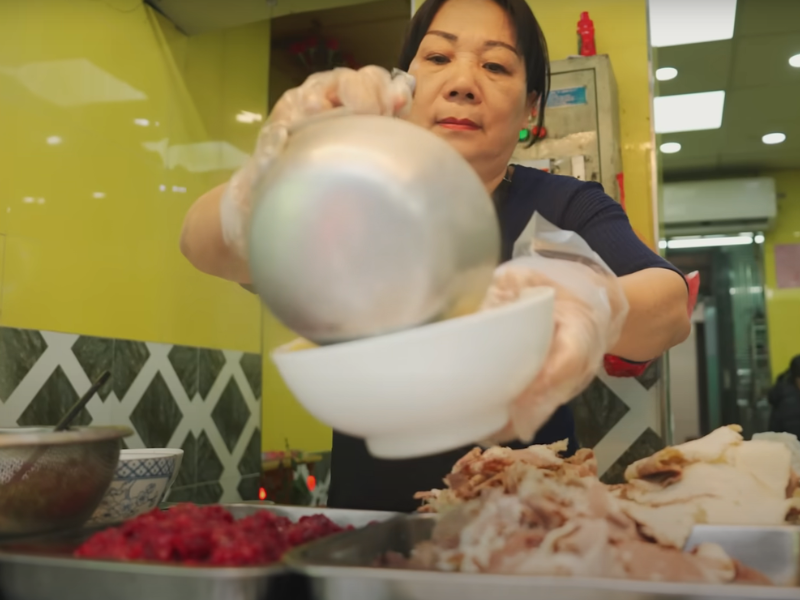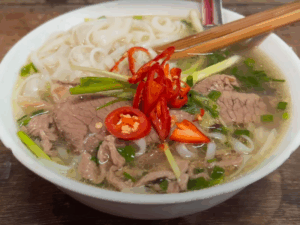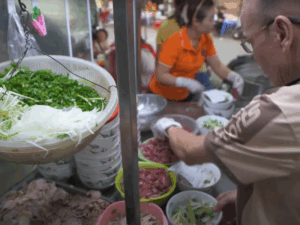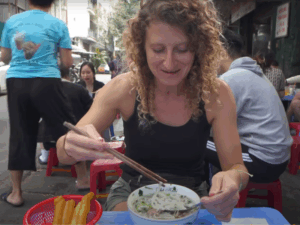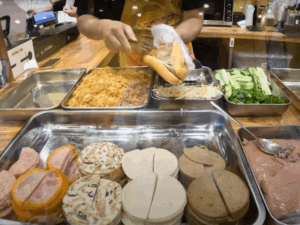Pho, pronounced “fuh,” is more than just a bowl of noodle soup. It’s a culinary treasure that has captivated hearts and taste buds around the world. Originating from Vietnam, pho is not just a dish; it’s an experience steeped in history, culture, and tradition. From humble street stalls in Hanoi to gourmet restaurants in Los Angeles, pho has traveled far and wide, earning its place as a beloved international dish. In this blog post, we’ll take you on a delicious journey through the world of pho. We’ll explore the anatomy of the perfect bowl, uncover the secrets of making authentic pho at home, and introduce you to some of the best pho restaurants around the globe. Whether you’re a seasoned pho enthusiast or a curious newcomer, there’s something here for everyone.
The Anatomy of a Perfect Bowl of Pho
The Broth
The soul of any pho lies in its broth. Traditionally made by simmering beef bones, oxtail, and a medley of spices for hours on end, the broth should be clear, aromatic, and deeply flavorful. Key spices include star anise, cinnamon, cloves, and cardamom, which lend their warm, fragrant notes to the broth. A well-made broth is a labor of love and patience, and it’s what sets a great pho apart from a merely good one.
The Noodles
Pho noodles are typically flat rice noodles called “banh pho.” They are soft yet resilient, holding up well in the hot broth without becoming mushy. The noodles should be cooked just before serving to ensure they retain their texture and absorb the flavors of the broth perfectly.
The Meats
Traditionally, pho is served with thinly sliced rare beef, brisket, or flank. Other variations include meatballs, tendon, and even tripe. The meat is often added raw to the steaming broth, cooking it just enough to retain its tenderness and flavor. For those who prefer poultry, chicken pho, or “pho ga,” is a lighter yet equally delicious alternative.
The Garnishes
No bowl of pho is complete without its garnishes. Fresh herbs like Thai basil, cilantro, and mint add a burst of freshness, while bean sprouts provide a satisfying crunch. Lime wedges, sliced chili peppers, and hoisin sauce offer additional layers of flavor, allowing each diner to customize their pho to their liking.
Exploring the Best Pho Restaurants Around the World
Pho 2000, Ho Chi Minh City, Vietnam
Located in the bustling streets of Ho Chi Minh City, Pho 2000 gained international fame when former President Bill Clinton dined here during his visit to Vietnam. Known for its rich, aromatic broth and generous portions, Pho 2000 offers an authentic taste of Vietnamese street food.
The Slanted Door, San Francisco, USA
Owned by renowned chef Charles Phan, The Slanted Door in San Francisco is a modern Vietnamese restaurant that has garnered numerous accolades. Their pho boasts a deep, flavorful broth and high-quality ingredients, making it a must-visit for pho enthusiasts.
Pho Bac, Seattle, USA
A family-owned gem, Pho Bac in Seattle has been serving up delicious pho for over 30 years. With a focus on authenticity and quality, their beef pho is a local favorite, attracting both residents and tourists alike.
Anan Saigon, Ho Chi Minh City, Vietnam
Chef Peter Cuong Franklin’s Anan Saigon offers a contemporary twist on traditional Vietnamese dishes. Their “Pho Beef Wellington” is a unique fusion dish that blends the classic flavors of pho with the luxuriousness of beef Wellington, creating an unforgettable dining experience.
Pho Thin, Hanoi, Vietnam
Pho Thin in Hanoi has been a local institution for decades. Known for its unique preparation method, where the beef is stir-fried with garlic before being added to the broth, Pho Thin offers a distinctive and flavorful take on the classic dish.
Secrets Behind Making Authentic Pho at Home
Step-by-Step Guide
Making pho at home may seem daunting, but with the right ingredients and a bit of patience, you can recreate this beloved dish in your own kitchen. Here’s a step-by-step guide to making authentic pho:
Gather Ingredients:
- Beef bones and oxtail
- Star anise, cinnamon sticks, cloves, cardamom pods
- Ginger, onions
- Fish sauce, salt, and sugar
- Flat rice noodles (banh pho)
- Thinly sliced beef, brisket, or chicken
- Fresh herbs (Thai basil, cilantro, mint)
- Bean sprouts, lime wedges, sliced chili peppers, hoisin sauce
Prepare the Broth:
- Roast the beef bones and oxtail in the oven until browned.
- Char the ginger and onions over an open flame or broil in the oven.
- In a large pot, combine the roasted bones, charred ginger and onions, spices, fish sauce, salt, and sugar.
- Add water and bring to a boil, then reduce heat and simmer for at least 4-6 hours, skimming off any impurities.
Cook the Noodles:
- Cook the rice noodles according to package instructions, then drain and rinse with cold water.
Assemble the Pho:
- Place noodles in bowls, top with meat slices, and ladle the hot broth over the top.
- Garnish with fresh herbs, bean sprouts, lime wedges, sliced chili peppers, and hoisin sauce.
Tips from Professional Chefs
- Andrea Nguyen suggests roasting the spices before adding them to the broth to enhance their flavors.
- Charles Phan recommends using a mix of different beef cuts for a richer broth.
- Viet Thanh Nguyen emphasizes the importance of balancing the flavors of sweet, salty, and umami in the broth.
Pho for Every Palate
Vegetarian Pho (Pho Chay)
For those who prefer a plant-based diet, vegetarian pho is a delicious alternative. The broth is made from a combination of vegetables, such as carrots, mushrooms, and daikon radish, along with aromatic spices. Tofu and a variety of fresh vegetables are used in place of meat, creating a light yet satisfying option.
Seafood Pho (Pho Hai San)
Seafood lovers will enjoy pho hai san, which features a seafood-based broth and a medley of fresh seafood such as shrimp, squid, and fish. The broth is typically lighter than the traditional beef version, allowing the delicate flavors of the seafood to shine through.
Regional Variations
Pho varies from region to region in Vietnam, each with its unique twist. For example, southern-style pho is known for its sweeter broth and wider range of garnishes, while northern-style pho is simpler and more focused on the purity of the broth.
The Future of Pho
Fusion Pho Dishes
As pho continues to gain popularity worldwide, chefs are experimenting with fusion dishes that blend traditional pho with other cuisines. Examples include pho tacos, pho burgers, and even pho-inspired cocktails. These creative interpretations breathe new life into the classic dish while introducing it to a wider audience.
Eco-Friendly Practices
Sustainability is becoming increasingly important in the culinary world, and pho restaurants are no exception. Many establishments are adopting eco-friendly practices, such as using locally sourced and organic ingredients, reducing food waste, and implementing energy-efficient cooking methods.
Technological Innovations
Advancements in technology are also shaping the future of pho. From online ordering and delivery services to apps that help diners find the best pho spots, technology is making it easier than ever for people to enjoy their favorite bowl of noodle soup.
Conclusion
In conclusion, pho is more than just a meal; it’s a cultural experience that brings people together. Whether you’re enjoying a bowl at a street stall in Vietnam or making it at home, the magic of pho lies in its ability to comfort and delight. We hope this guide has inspired you to explore the world of pho, try new variations, and maybe even make your own at home.
Share your pho adventures with us on social media using #PhoJourneys #pho restaurants, and visit our website for more culinary insights and recipes. Happy slurping!
For more related content, check out our Vietnamese Cuisine Guide, Homemade Soup Recipes, and Top Asian Food Destinations.
- The Best Exotic Vietnam – 16 Days / 15 Nights (75 views)
- Uncover Cambodia’s Hidden Charms 6 Days / 5 Nights (69 views)
- Top Vietnam Tour Operators – The Ultimate Guide to the Best Tour Companies for Vietnam (37 views)
- Seamless Cruise: Halong Bay to Da Nang – Fostering smooth travel experience from Halong Bay to Da Nang. (36 views)
- Vietnam Culinary Tour: Your Definitive Guide to a Food Lover’s Journey (34 views)

